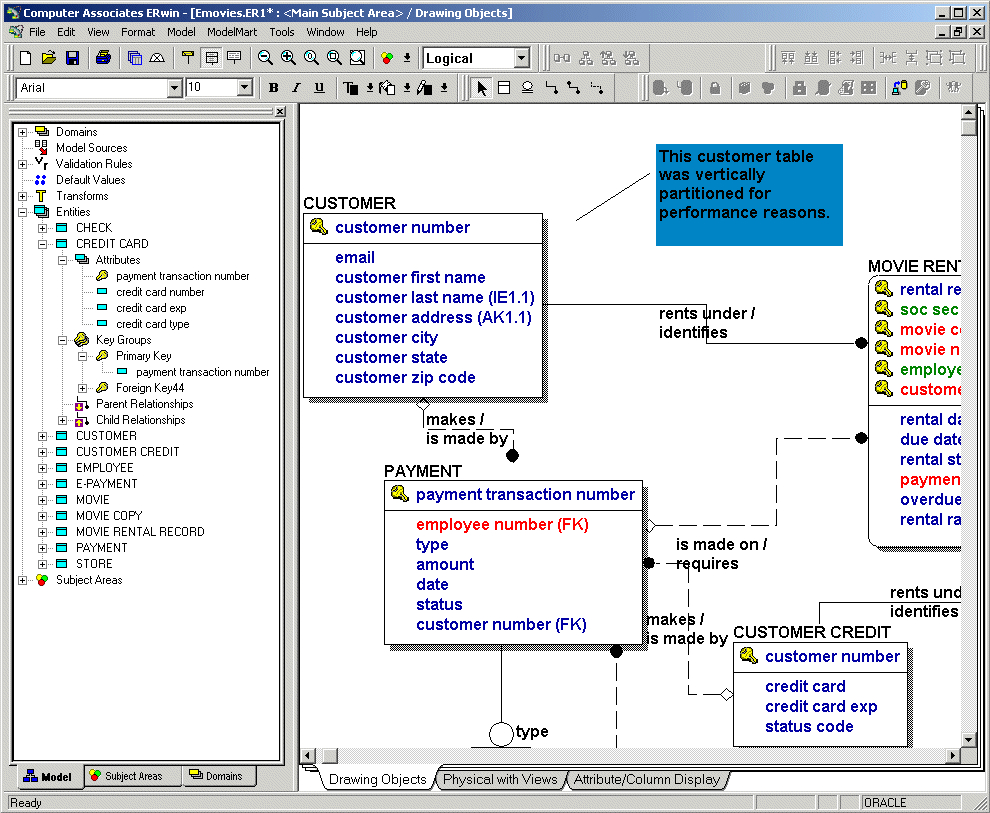

A file that appears to contain two models actually contains a single model with two views, logical and physical. Each ERwin file can contain one logical data model, one physical data model, or one of each. Before the release of r7, the predecessor to r8, ERwin focused completely on the development of tightly-coupled pairs of logical and physical data models. CA ERwin r8.1 Data Modeler On their web site, CA describes ERwin Data Modeler as “an industry-leading data modeling solution that provides a simple, visual interface to manage your complex data environment”. However, when you look more deeply into how these features are delivered, you’ll see that ERwin does not come close to matching the breadth and depth of capability provided by PowerDesigner. They both provide essential collaborative features such as a repository. They both allow you to share the information held in your models via reports, though only one provides a web portal. They also provide standard usability features such as undo/redo, and the ability to customize the style of your diagrams. Both tools provide a drawing canvas, and a variety of editing facilities for use in expanding the detail of the model. Both enable you to reverse-engineer databases, to persist the design in a model, and generate changes to the database. Both enable you to create different types of data models, and link those data models to each other. PRODUcT OVERVIEWS Sybase PowerDesigner and CA ERwin Data Modeler are two of the market-leading data modeling tools available. The CA ERwin Data Modeler evaluation provides a limited set of capabilities - the Standard edition, which does not include the repository capability.
#Ca erwin data modeler review full#
The PowerDesigner evaluation software provides the full capabilities, including a repository. In this review, I examine the capabilities provided by CA ERwin Data Modeler r8.1 Standard Edition, and Sybase PowerDesigner 16.0 InformationArchitect, using the evaluation editions available on each company’s web site. However, when you are connecting data models to components of the broader architecture, I encourage you to read on to understand how CA ERwin compares to PowerDesigner InformationArchitect. If all you need to do is create data models for an individual database, it is recommended you seek the cheapest tool or one that suits your specific technical deployment needs. For this reason, this review will use the InformationArchitect version of Sybase PowerDesigner rather than their DataArchitect version. When you need to manage a data center across the enterprise, integrating with a wider set of business and technology activities is critical to success. We need support for different types of data models, and for managing the relationships between data and the rest of the organization. To truly understand and manage our data, and the impact of changes to that data, we need to manage more than just models of data in databases.

Data does not exist in isolation, it is created, managed and consumed by business processes, and those business processes are implemented using a variety of applications and technologies. INTRODUcTION Data modeling is more than just database design, because data doesn’t just exist in databases.
#Ca erwin data modeler review update#
TabLE OF CONTENTS 1 Product Overviews 1 2 3 5 6 7 10 10 10 11 11 16 17 18 CA ERwin r8.1 Data Modeler Sybase PowerDesigner 16.0 Overview Types of Data Model Design Layers Managing the SAM-LDM Relationship Forward and Reverse Engineering Summary Integrating Data Models with Requirements and Processes Generating Object-oriented Models Dependency Analysis Model Comparisons and Merges Update Flows Core Modelingġ8 Required Features for a Data Modeling Tool 26 Collaboration 29 Interfaces & Integration 39 Adding Value to Data Modeling 39 Managing Models as a Project 40 Dependency Matrices 41 Conclusions 41 Acknowledgements 41 Bibliography 41 About the Author CA ERwin Data Modeler r8.1 Standard Edition A Comprehensive Analysis of Sybase® PowerDesigner® 16.0 InformationArchitect vs.


 0 kommentar(er)
0 kommentar(er)
